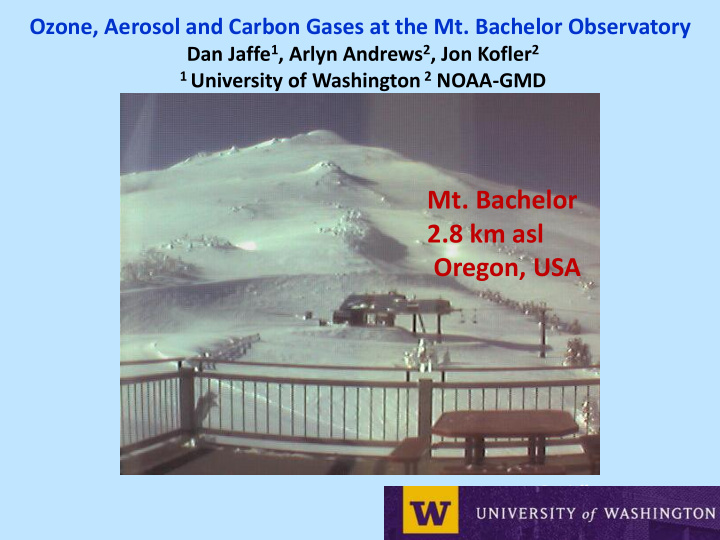



Ozone, Aerosol and Carbon Gases at the Mt. Bachelor Observatory Dan Jaffe 1 , Arlyn Andrews 2 , Jon Kofler 2 1 University of Washington 2 NOAA-GMD Mt. Bachelor 2.8 km asl Oregon, USA Dan Jaffe
Mt. Bachelor, Oregon, (MBO) 2.8 km asl The only high elevation/free trop research site on west coast of U.S. Continuous observations of CO, O 3 and aerosols since 2004; Frequent detection of Asian pollution and biomass burning plumes; More than 40 papers since 2004 on O 3 , PM. Hg, LRT, wildfires, etc. Key goal: Identify importance of background sources on US air quality. Dan Jaffe
Chemical measurements at MBO Continuous (most since 2004): CO and CO 2 Cavity Ring Down Spectroscopy • O 3 : UV spectroscopy • Aerosol scattering (continuous PM1, PM2.5) • Aerosol absorption (PSAP/TAP) • Campaigns: NOx/NOy: Chemiluminescence spectroscopy • Peroxyacetyl nitrate (PAN): Gas chromatography, CIMS • Mercury (Hg): Cold vapor atomic fluorescence (CVAFS) • Hydrocarbons: Gas chromatography/mass spec. • Acids (H 2 SO 4 , HNO 3 ): Ion chromatography, CIMS • Aerosol chemistry: X-ray fluorescence, AMS (Zhang UCD) • Aerosol size distribution (SMPS/nano-SMPS-Lee-UAH) • Aerosol Black Carbon: SP2 (Sedlacek-BNL and UCD–Cappa-UCD) • Dan Jaffe
Diurnal circulation pattern at Mt. Bachelor Day: upslope flow brings modified ν h BL air to summit. This air is more humid and usually low in O 3 . Night: downslope flows brings Free Tropospheric (FT) air to the summit. This air is dry and usually high in O 3 . ID of Free Tropospheric Air Time of day. Water vapor mixing ratio. Chairlift soundings. Observations of NOx Weiss 2006, 2007; Fischer 2009; 2010; Reidmiller 2011 Dan Jaffe
Mean diurnal cycle-Spring FLASK SAMPLES 0400 LT = 12 GMT Use WV mixing ratio as a criteria to separate FT/BL Influenced (BLI) air McClure et al 2016- Dan Jaffe AAQR Mtn top special issue
Some past and current work at MBO Identification of long-range transport of CO, O 3 , aerosols and Hg from Asia to the US; Identification of a significant under-estimate in Asian emissions of Hg; Identification of a significant source of Hg 2+ in the free troposphere; Identification of micro-organisms in free troposphere. Use of MBO observations to understand NOy, PAN, O 3 and PM chemistry in wildfire plumes. Positive trend in spring and summer O 3 and negative trend in CO over past decade. Sources of O 3 in the free trop. Aerosol properties, SSA, Å, size distributions in Asian and fire plumes. Constraints on the inflow of background O 3 to the US. Look at consistency of multiple methods to measure BC. Examination BC/CO ratios in LRT to constrain BC lifetime. Collaboration with more than 20 diff. groups (Universities, Gov labs, etc) Dan Jaffe
Collaboration with NOAA-GMD • Prior to 2012 CO measurements with a Thermo 48CTL; • Starting in April 2012, we installed a CRDS from Picarro for higher precision CO, CO 2 and WV. • NOAA (Kofler) has provided invaluable support for maintenance and calibration of the Picarro. • GMD flask samples started in October 2011, now doing daily samples at 12Z, which is most likely time for free trop air. • 940 samples to date; 55% Free trop, 41% Boundary Layer Influenced (BLI) using WV criteria. Dan Jaffe
CO in the Free Trop and “BL Influenced” Air Asian influence Wildfire influence Asian influence seen mostly in FT Dan Jaffe Wildfire influence seen in BL and FT
CO 2 in the Free Trop and “BL Influenced” Air Dan Jaffe
CH 4 in the Free Trop and “BL Influenced” Air Dan Jaffe
C 3 H 8 in the Free Trop and “BL Influenced” Air Dan Jaffe
C 3 H 8 (propane) vs Flask CO Dan Jaffe
C 3 H 8 (propane) vs Flask CO- all data Asian Industrial ratio Siberian smoke event- 7/31/2016, 12Z Transported in very dry air Dan Jaffe
Value in real time data UTLS UTLS + Asian? Dan Jaffe
Summary • MBO is an excellent site to observe free tropospheric inflow into North America, Asian and wildfire plumes. Observations of CO 2 , CH 4 , etc can give information on NA boundary conditions and help constrain global fluxes; • In spring, CO, CO 2 , CH 4 , C 3 H 8 , O 3 , etc are all higher in FT air compared to the BL. • Enhancement ratios with CO provide key information on source type and processing enroute. (ERs with CO 2 more challenging to interpret). • Daily flask obs at 12Z is ideal sampling time to sample FT inflow. • O 3 is a key pollutant at MBO since US standard now 70 ppb. We see many days at MBO with O 3 in excess of this value and identifying source is important for understanding US air quality. Since 2004, we see positive trends in O 3 in spring, summer and fall. Dan Jaffe Collaborations welcome!
In-situ CO vs Flask CO Dan Jaffe
Recommend
More recommend